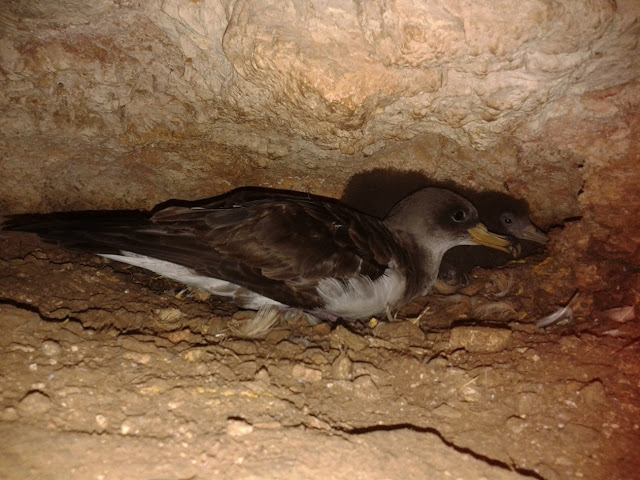Hello all!
My name is Elisa and this week it is my turn to update the Skomer blog, so here it is.
I am the Skomer Island Field Worker and this
is my second season. My main roll on the
island is to monitor seabirds as part of the island seabird long term
monitoring program. I am responsible for conducting productivity studies on Guillemots,
Razorbills, Kittiwakes, Fulmars and Great Black-backed Gulls. Furthermore I do
Guillemot and Razorbill plot counts during June, and at the end of the
breeding season I also perform a diet survey of one of our main predators: the Great
Back- blacked Gull.
All the information I gather, together with all the other seabird studies done by other Field Workers, for example studies on adult survival, tell us how our seabirds are doing year
after year and allow us to support conservation decisions that will help to
preserve the populations of the birds.
 |
|
Guillemot
colony early on in the breeding season
|
To get the job done,
it requires me to spend most of the day outdoors sitting close to very noisy
and busy cliffs, while looking through my scope at a great number of birds which are working
hard to succeed in their breeding attempts (fighting against predators trying to
take their eggs and chicks, as well as against bad weather conditions). Quite an
interesting office atmosphere, I have to admit!
 |
|
One of my
study sites at The Wick
|
Now in June all the staff are pretty busy with seabird monitoring. Our
early breeders (the Guillemots, the Razorbills and the Puffins) have already got chicks and the rest of the island seabirds are on eggs. This is why June is the perfect time for us to perform population counts. The Wildlife Trust of
South and West Wales started to count seabirds back in the sixties, which means
that we have over 50 years of seabird data for the island; an incredibly
valuable data-set.
 |
|
Me counting
Razorbills with a curious puffin hanging around. ©Phil Kemp
|
It is a great work experience
to be able to contribute to Skomer's long term seabird data-set, but
being on Skomer is also a fantastic life experience. It is really cool to have
the warden team and volunteers, the field workers and the researchers all
together joining efforts in order to learn more about the island wildlife. All
living and working close to each other in a small community, very openly
sharing duties and knowledge.
However, I don't live on Skomer all year round; I only spend four
months on the island (from mid April to mid August). So, as some seabird species, I winter in
warmer areas (Mallorca, where I am from) and come to the island to spend the
summer! Definitely, not a bad thing to do!
Some of you may ask yourself: what is Elisa doing during the rest of the year? Back home, I also have another
very exiting field worker seasonal job! I work with Barcelona University
tracking Scopoli’s Shearwaters that breed on islets around the Mediterranean.
 |
|
Scopoli’s Shearwater nest, adult and its chick. Palomas Island, Murcia, Spain. ©Jason
Moss
|
We deploy GPS loggers
on breeding birds and study their uses of the marine environment around the
colony (feeding areas, resting areas, and areas they use most to move around). But
also, we deploy geolocator devices with two purposes. We use them
to learn about the daily activity of the birds when they are out at sea (if the birds
are in the water or flying), which allows us to characterise the behaviour of
the birds during the GPS tracking. Further to this we follow them during the
whole year in order to find out where they spend the non-breeding season.
Any
guesses on where the non-breeding grounds for Scopoli’s shearwaters are?
Scopoli’s Shearwaters breed on the Mediterranean coastline, and during the
winter most of them migrate offshore to NW Africa, but also some go further South offshore of Namibia and South Africa. They definitely take advantage of the
ability to soar, a low cost way of flying which characterises shearwaters.
 |
|
Scopoli’s Shearwater with a GPS-logger on its back and a geolocator on its leg. ©Jason
Moss
|
I am very excited also
about next winter, as I am potentially going to be back on Skomer to assist the
wardens with seal monitoring work. Looks like great times are ahead!
Elisa Miquel Riera (Field Worker)
No comments:
Post a Comment